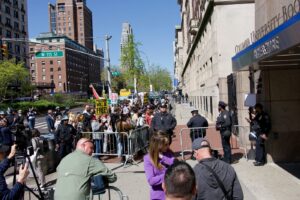In April of this year, in Oceanside, California, thirty-eight Crips gang members, their alleged associates, and two hotel owners were arrested for engaging in a sex trafficking enterprise that involved the prostitution of minors and adult females. After raping their victims and threatening to kill them if they tried to escape, the gang members sold the girls online. The girls were trapped in a hotel for twelve hours a day, as men who had purchased their bodies from the gang members had sex with them. Though these commercial sex acts brought in between $1,000 to $3,000 dollars a day, the young women and children never saw a penny of the money. Their only payment was food, avoiding beatings, and staying alive.
In a similar case this past June, an MS-13 gang member was indicted for trafficking girls at a Super 8 motel just outside of Washington, D.C. At least one of the girls was only fifteen when she was sold. He advertised her as a “high school girl” and “fresh out of the box.” A year earlier, in Brooklyn, New York, eight members of the Bloods street gang were also charged with sex trafficking of minors. They solicited customers using online websites. The victims, recruited from local junior high and high schools, were trafficked into prostitution. The traffickers made $500 a day.
The facts from hundreds of criminal cases show a clear link between dangerous street gangs and the scourge of human trafficking. Over the last decade, the United States has passed numerous laws to address criminal gang activity. Similarly, in 2000, Congress passed the Trafficking Victims Protection Act (TVPA) to curtail trafficking in persons. But the enforcement of each law has developed independently of the others, with little, if any, integration. This is unfortunate and represents a missed opportunity not only to save the victims of a terrible crime, but also to add another prosecution weapon against the dangerous street gangs that endanger our communities and our nation.
With state and national crackdowns on drug trafficking, gangs have turned to sex trafficking for financial gain. Unlike drugs, girls can be used more than once, and it is the girls, not the traffickers, who run the greatest risk of being caught and prosecuted. Case records show that gangs still utilize traditional methods of recruiting, employing the modern equivalent of wining and dining a young girl (“skip parties” and “love showers”), winning her heart and then slowly “seasoning” her for the street by sharing her with other gang members. One young woman described her trafficker’s request for a “love donation”: sex she had to provide to other men to win her place in the gang.
Start your day with Public Discourse
Sign up and get our daily essays sent straight to your inbox.But women and children also describe being coerced into a life of prostitution after being subjected to severe beatings and gang rapes, and being deprived of food and water. The victims of trafficking are made to feel both afraid of and dependent on the traffickers for their very lives.
New technological advances give gang traffickers the ability to market the services of their victims discreetly. In several high-profile prosecutions of sex trafficking in Seattle, San Diego, and New York, street gangs used online advertisements on websites such as Craigslist and Backpage to traffic women and girls as young as thirteen. Once arrangements are made over the internet and by cell phone, the victimization that takes place behind closed doors is the same as in other trafficking cases: women and children are delivered to customers and forced to perform sex acts for money that is paid to and pocketed by their traffickers.
The U.S. government has prosecuted several hundred cases against street gangs, motorcycle gangs, and prison gangs in which commercial sex acts, prostitution, or human trafficking were mentioned; the gang members, however, were charged with drug and weapons trafficking, armed robbery, auto theft, extortion, home invasions, and other felony offenses—not human trafficking. Human trafficking charges are rarely the primary basis for prosecution; though, since late 2010, there have been a few such cases.
One reason that street gangs have not been prosecuted for human trafficking is that too many prosecutors and law enforcement officials assume that human trafficking in America is primarily an international problem. A recent Department of Justice Bureau of Justice Statistics report, however, found that 83% of victims in confirmed sex trafficking incidents are actually U.S. citizens.
The vigorous prosecution of human trafficking can help bring down street gangs that also engage in murder, robbery, and drug trafficking. Before that can happen, however, state and local government officials must learn how to combat the human trafficking that is occurring in their own backyards. The Department of State’s 2011 Trafficking in Persons Report found that less than 10 percent of state and local law enforcement agencies have any kind of protocol or policy on human trafficking. While great strides have been made in addressing international human trafficking and local street gang activity, little has been done to link the two.
In order to combat street gang involvement in human trafficking more effectively, new approaches must be undertaken: (1) State and local governments must add human trafficking to the list of suspect activities for criminal gangs; (2) gang and human trafficking task forces must coordinate and plan joint prosecutions; (3) gang investigations should include specific tactics for actively spotting human trafficking; (4) gangs involved in human trafficking should be charged under the TVPA or state trafficking-in-persons laws in addition to other criminal charges; (5) communities should develop specialized outreach, education, and training programs to address gang-related trafficking; (6) asset forfeiture laws should be utilized more extensively in gang-related human trafficking cases; and (7) new and creative approaches to prosecution (such as using the child soldiers provision in the TVPA) should be explored and established.
Street gangs are increasingly turning to human trafficking as a way to generate the funds that are necessary for their existence and operations. Little is known about the dynamics involved in this trafficking, and additional research on the methods of recruiting, transporting, harboring, marketing, buying, and selling involved in gang-related human trafficking is important.
We do know, however, that street gangs engage in human trafficking because the risk is low and the profit is high. We must draft and pass new laws targeting gang-related human trafficking. In addition, diligent law enforcement tactics that help identify street gangs involved in human trafficking must be developed. Federal and local law enforcement authorities should encourage collaboration between the current efforts to address human trafficking and prosecute street gangs. Finally, education about street gangs and human trafficking that is tailored for parents, teachers, and community leaders is critical to strengthening community resistance to human trafficking and other criminal gang activities.
A longer version of this article on street gangs and human trafficking will be available November 1, 2011, in the Johns Hopkins University Journal of Human Rights.












